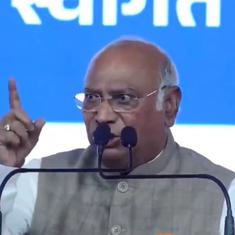Perhaps it is the hallmark of the rarest of rare breed of actors. Every fan, every follower, every devotee will have a different image of the star to carry home. Sridevi was a member of this breed. While some mourned the loss of the braided and awkward girl-woman in Sadma, others recalled the vision in white in Chandni. There were others who were nostalgic about the outlandish headgear that only Sridevi could carry off as Hawa Hawai, as though she was born to storm the costume drama.
Sridevi doing the rain dance in Chaalbaaz, flirting with an invisible man in Mr India, singing paeans to her bangles in Lamhe, engaging in a sexually charged sport with Amitabh Bachchan in Khuda Gawah and, many years later, turning perfect laddoos in English Vinglish – she could be anybody her directors wanted her to be, perhaps because she preferred to be a nobody once the lights went off and the director called it a day. Among the last of a generation of stars who remained inaccessible. An enigma, by design.
There were many stories about Sridevi’s early years as a child actor, of the circumstances that forced her to put on the war paint and look older than her tender years. It could not have been pleasant. She belonged to a time when young girls were pushed into the industry by zealous, parents. Some survived. Many didn’t. Rekha and Sridevi were among those who aced the test – perhaps at a great personal cost.
A star you could worship
While Rekha worked on her physical appeal, her demeanour and her diction, Sridevi could not even speak in her own voice. If Rekha made for the perfect courtesan, Sridevi was the star you could worship. If one had smouldering screen presence, the other personified a more wholesome glamour.
Both Rekha, who mentored Sridevi for some years, and Madhuri Dixit, who dethroned Sridevi with her bosom thrusts, were products of the male gaze. Men fantasised about them. They were in their naughtiest thoughts. But Sridevi managed to de-sexualise herself with terrific effect. Even when she rocked the blue chiffon saree in Mr India, no one cried obscenity. It was sensuous, yes. But there was nothing about her moves and her body language – even when she was dressed in the worst of 1980s fashion – that could alienate her female and young fans.
At the same time, Sridevi managed to create her signature moves, giving her male audiences and the front-benchers enough to keep coming back for her films. Even when she was in her fifties, dressed in cotton sarees and making laddoos. But there was pressure. There were whispers about how she had tired of the spotlight and wanted nothing more than to be a wife and mother to her two daughters, and may have been compelled to get on to the battlefield after 15 years to support her husband’s many doomed projects.
The price of fame
Body-shamed for her “thunder thighs” and sometimes ridiculed for being dubbed in many of her films, Sridevi may not always have had a smooth ride. But there was a quiet defiance in the way she took on every role that was offered to her. In an interview given to this journalist last year, before the release of Mom, the 54-year-old actress looked like someone who was going through the motions. At the time, one thought she was simply playing calm. But there were some signs that she was perhaps battling her own little battles.
Sridevi’s face – one of the most expressive ones in the film industry ever – was pallid. Her eyes, which could narrate an entire film in the fraction of a second, were lifeless. She rarely blinked, and kept administering eye drops to herself between interviews. Her words came out with tremendous effort. She had been travelling around the country to promote her film, because, as she said: “Earlier, you gave two or three interviews and you were done. Things have changed and you change with the times.”
She was almost inaudible, but her hair was perfectly blow-dried, the elaborate white dress perfectly ironed and laid out in a white fluff, giving her the appearance of a swan. She did not care for the compliments. “I wear whatever they give me,” she said. One walked out of the room with a sense of disquiet.
Sridevi was always the kind of star who came alive only when the camera was on. Once the lights were out, it was back to being a woman – with her scars and her many stories that she refused to share with the world.
There were many Sridevis who entertained Indian audiences for decades. But there was always the elusive one who would leave in the last train from Ooty, carrying her true story with her.










